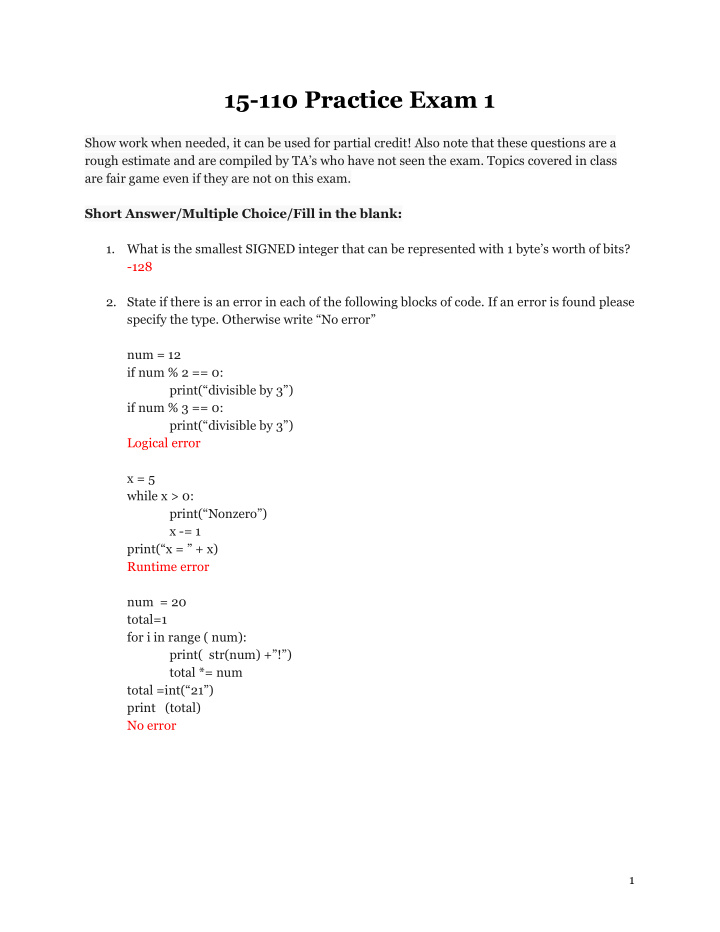



15-110 Practice Exam 1 Show work when needed, it can be used for partial credit! Also note that these questions are a rough estimate and are compiled by TA’s who have not seen the exam. Topics covered in class are fair game even if they are not on this exam. Short Answer/Multiple Choice/Fill in the blank: 1. What is the smallest SIGNED integer that can be represented with 1 byte’s worth of bits? -128 2. State if there is an error in each of the following blocks of code. If an error is found please specify the type. Otherwise write “No error” num = 12 if num % 2 == 0: print(“divisible by 3”) if num % 3 == 0: print(“divisible by 3”) Logical error x = 5 while x > 0: print(“Nonzero”) x -= 1 print(“x = ” + x) Runtime error num = 20 total=1 for i in range ( num): print( str(num) +”!”) total *= num total =int(“21”) print (total) No error 1
x = 5 y = 2 if x == 5: y -= 2 print(“y is equal to 0”) if y == 0: print(x / y) else: print(x is equal to “ + str(x)) Syntax error (they always occur before runtime!) 3. What is the purpose of c_in and c_out in a full adder? To carry a value while adding multi digit numbers. 4. What would you use to sum two numbers that are greater than 1? N-bit adder 5. What would you use to save the state of a bit? Flip flop 6. Convert 53 to binary using 1o bits 0000110101 7. What is 1110 + 0101 (binary)? 10011 (19) 8. What boolean operation is this equivalent to? And gate 2
Code Tracing: Provide the outputs from the given functions 9. def ct(s, n): result = '' if len(s) % n == 0: result += s[:n] elif len(s) // n == 1: result += s[n:] else: return None return result print(ct('Apple', 2)) print(ct('Pear', 4)) print(ct('Orange', 3)) None Pear Ora 10. def f(x, y, z): result = ‘’ if (x+y)%3 == 1: result += str(x) if (y+z)%2 == 0: result = str(y) + result if z%2 == 1: result = result + str(z) return result print( f(3,4,8), f(1,3,3)) 43 313 11. def ct2(x, y): Result = 0 for z in range (x,y): if (z%2==1): print (z, result) result += z%10 return result print(ct2(20, 30)) 21 0 23 1 25 4 3
27 9 29 16 Free Response: 12. Write a function hello that takes in an integer x and prints “Hello” x times if x is not a multiple of 3. Return true if the function printed “Hello” and false otherwise. def hello(x): if x % 3 != 0: for i in range(x): print(“Hello”) return True return False 13. Write a function stringSum that takes in a string containing numbers separated by “+” characters and return the integer sum of these numbers. def stringSum(s): sum = 0 for i in s.split(“+”): sum += int(i) return sum 14. Convert the following flowchart into the function scheduler, which takes as input the variables day, time, and recitation. 4
def scheduler(day, time, recitation): print(“Good morning”) if day == “Sat” or day == “Sun”: print(“I’m free”) elif day == “Mon” or day == “Wed” or day == “Fri”: if time > 2.5 and time < 4.5: print(“I have 110 lecture”) else: print(“I’m free”) elif day == “Thurs”: if recitation - time < 1 and recitation - time >-1: print(“I have 110 recitation”) else: print(“I’m free”) else: print(“I’m free”) 5
Recommend
More recommend